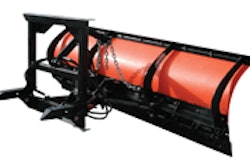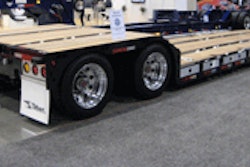
HBP breakers work perfectly from the auxiliary output of most skid steers when used in conjunction with an oil flow divider. The oil flow divider is necessary to ensure that the correct oil flow and pressure is sent to the breaker at all times. This combination maximizes flexibility and optimal equipment utilization. Don’t be mistaken; the HBP Breakers will also work on a standard power pack providing the user with additional location flexibility.
“The ability to run these breakers from the Power Take Off (PTO) outlet of a skid steer offers users access to all the productivity benefits of high-powered hydraulic hand tools, without the financial commitment to a conventional power pack,” says Eudes Defoe, product manager, light compaction and handheld tools, Chicago Pneumatic Construction Equipment. “Our new line of HBP hydraulic breakers have been tested with most of the major skid steer brands of on the market, and they have performed flawlessly.”
Able to accept up to 515 psi (35 bar) of back pressure — standard breakers accept 147-220 psi (10-15 bar)— their high pressure tolerance also permits the use of much longer hoses on job sites where space and access can be an issue.
BRK 55 HBP
A medium weight, multi-purpose breaker, the BRK 55 HBP is a reliable choice for road building and maintenance applications such as asphalt, brickwork, frozen soil, or concrete. Used in conjunction with an oil flow divider, The BRK 55 HBP can be used from the PTO outlet of most skid steers, and can be easily adjusted to work with both 8 gpm and 5 gpm (30 l/min and 20 l/min) power packs.
BRK 70 HBP
The BRK 70 HBP breakers are ideal for heavier demolition jobs, and are suitable for use on tough materials such as asphalt, frozen soil, and reinforced concrete. Used in conjunction with an oil flow divider, The BRK 70 HBP can be used from the PTO outlet of most skid steers, and works with both 8 gpm and 5 gpm (30 l/min and 20 l/min) power packs.
BRK 95 HBP
The BRK 95 HBP is Chicago Pneumatic’s super-duty hydraulic breaker. Falling in the 100 ft. lb. impact power class, the BRK 95 HBP is powerful enough to replace a small excavator with a breaker attachment in certain situations. Ideal for breaking heavy asphalt, reinforced concrete and foundations, these powerful machines are the rugged choice for utility construction, street maintenance, water and gas line repair and general heavy-duty construction jobs. Used in conjunction with an oil flow divider, The BRK 95 HBP can be used from the PTO outlet of most skid steers, and works with both 10 gpm and 8 gpm (40 l/min and 30 l/min) power packs.
Hydraulic Features
All Chicago Pneumatic handheld hydraulic breakers feature a well-balanced, slim body design with no external side bolts or protruding machine parts. This feature provides an accurate line of site to the working surface and minimizes operator fatigue.
Chicago Pneumatic hydraulic hoses, power packs and handheld hydraulic tools are fitted with flat-faced, quick-release couplings for fast and easy connections in all working situations. The couplings are designed to help keep hydraulic systems clean on work sites where there are large amounts of dust and dirt. The male and female couplings are mounted according to EHTMA (European Hydraulic Tools Manufacturers) standards, ensuring that no mistakes can be made on connections and that the direction of the oil flow is always correct.













